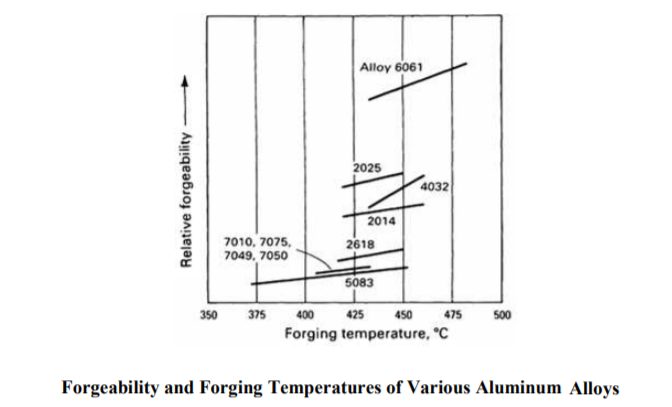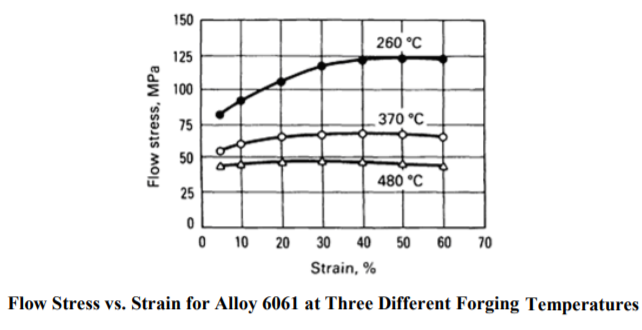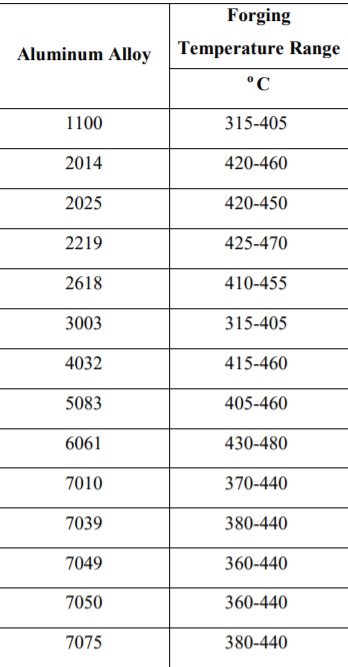Aluminum Forging Temperature
Most of the aluminum forgings are produced under hot forging condition. During aluminum forging process, the temperature used is a critical factor, which should be controlled strickly, higher or lower temperature will all easily cause forging defects. Before forging, aluminum alloy billets are heated fairly below their solidus temperature, because the heat generated during forging deformation will also cause a temperature rise in the material. If the heated billet temperature and the temperature rise during drop forging exceed the melting temperature of aluminum alloys, the aluminum billets will start to melt, and severe cracking of forgings will be seen. This effect is mostly significant in high-speed forging, such as on a mechanical press or forging hammer, because the heat generated has little time to diffuse into the dies. This reduces the complexity of the shapes that can be produced on high-speed forging equipment and potentially increases the amount of machining required.
On the other hand, with the temperature increase of aluminum billets after heating, the forgeability of all aluminum alloys will also be improved. As the forgeability of each aluminum alloy is different, the heating temperature required during hot forging process is also different. Below picture shows forgeability of different aluminum alloys with respect to temperature changes are given. From this picture we can well see that as the temperature increases forgeability increases.

However, changes in high-strength alloys such as 7075 are relatively small when compared to the low strength alloys. In Figure 2.3, effect of temperature on flow stress can be seen. A highly forgeable aluminum alloy 6061 at a strain rate of 10 s-1 is forged for different temperatures and dramatic reduction in flow stress is shown in the figure. It is easily seen from the figure that there is nearly a 50 % increase in flow stress between the highest forging temperature 480 °C and 370 °C.

Temperature Ranges Recommended for Forging Aluminum Alloys are listed in Below Table
 In general, most aluminum alloys are forged at about 55℃ below the melting point temperature, but with dependence on the speed and on the total amount of deformation. Since the material becomes brittle at the beginning of melting, appropriate temperature should be chosen for the additional heat is generated during forging operation may result in melting of aluminum alloy in rapid deformation.
In general, most aluminum alloys are forged at about 55℃ below the melting point temperature, but with dependence on the speed and on the total amount of deformation. Since the material becomes brittle at the beginning of melting, appropriate temperature should be chosen for the additional heat is generated during forging operation may result in melting of aluminum alloy in rapid deformation.
From these datas, the forging temperature ranges for most alloys are relatively narrow. Because of this, obtaining and maintaining proper temperatures in the forging of aluminum alloys is critical to the success of achieving quality aluminum forgings.
On the other hand, with the temperature increase of aluminum billets after heating, the forgeability of all aluminum alloys will also be improved. As the forgeability of each aluminum alloy is different, the heating temperature required during hot forging process is also different. Below picture shows forgeability of different aluminum alloys with respect to temperature changes are given. From this picture we can well see that as the temperature increases forgeability increases.

However, changes in high-strength alloys such as 7075 are relatively small when compared to the low strength alloys. In Figure 2.3, effect of temperature on flow stress can be seen. A highly forgeable aluminum alloy 6061 at a strain rate of 10 s-1 is forged for different temperatures and dramatic reduction in flow stress is shown in the figure. It is easily seen from the figure that there is nearly a 50 % increase in flow stress between the highest forging temperature 480 °C and 370 °C.

Temperature Ranges Recommended for Forging Aluminum Alloys are listed in Below Table

From these datas, the forging temperature ranges for most alloys are relatively narrow. Because of this, obtaining and maintaining proper temperatures in the forging of aluminum alloys is critical to the success of achieving quality aluminum forgings.


 sales@dropforging.net
sales@dropforging.net